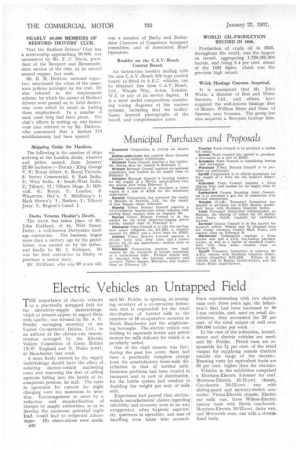Electric Vehicles an Untapped Field
Page 30

If you've noticed an error in this article please click here to report it so we can fix it.
THE importance of electric vehicles as a practically untapped field for the electricity-supply undertakings. which at present appear to regard them with apathy, was stressed by Mr, A. G. Peddie, managing secretary of the United Co-operative Dairies, Ltd., in an address at the electric-van demonstration arranged by the Electric Vehicle Committee of Great Britain (N.W. England and N. Wales Area), at Manchester, last week.
A more lively interest by the supplj, undertakings should have the effect of, reducing electric-vehicle marketing costs and removing the fear of selling agencies falling into the hands of incompetent persons, he said. The rates in operation for current for night charging were too numerous to mention. Encouragement to users by a reduction and standardization of charges by supply authorities, so as to develop the enormous potential night load, would lead to reciprocal advantages. His observations were made,
B20
said Mr. Peddie, in opening, as managing secretary of a co-operative federation that is responsible for the retail distribution of bottled milk to the members of 16 co-operative societies in North Manchester and the neighbouring boroughs. The electric vehicle was tending to supersede horses and petrol motors for milk delivery for which it is peculiarly suited.
One of the chief reasons was that, during the past few years, there had been a practically complete change from the unsatisfactory loose-milk distribution to that of bottled milk. Immense problems had been created in transport and in cost of distribution, for the bottle system had resulted in doubling the weight per unit of milk sold.
Experience had proved that electricvehicle manufacturers' claims regarding reliability and economy were in no way exaggerated, when hygienic superiority, quietness in operation, and ease of handling, were taken into account. Since experimenting with two electric vans over three years ago, the federation's fleet had been increased to 40 1-ton vehicles, and, used on retail distribution, they accounted for 25 per cent. of the total output of well over 500,000 bottles per week.
In the case of the federation, horsed, motor and electric vehicles are used;said Mr. Peddie. Petrol vans are responsible for 71 per cent, of the retail output for supplying remote districts outside the range of the electrics. Running costs for equivalent loads are 50 per cent. higher than for electrics.
Vehicles in the exhibition comprised a Morrison-Electric 3-tonner for coal, Morrison-Electric 10-12-cwt. chassis, Clecolectric 10-12-cwt. van with sliding-panel and mercury-switch controller, Victor-Electric chassis, Electricar milk van, three Wilson-Electric bakery vans with Hovis coachwork. Morrison-Electric 10-12-cwt. dairy van, and Metrovick vans, one with a streamlined body.
















































































































